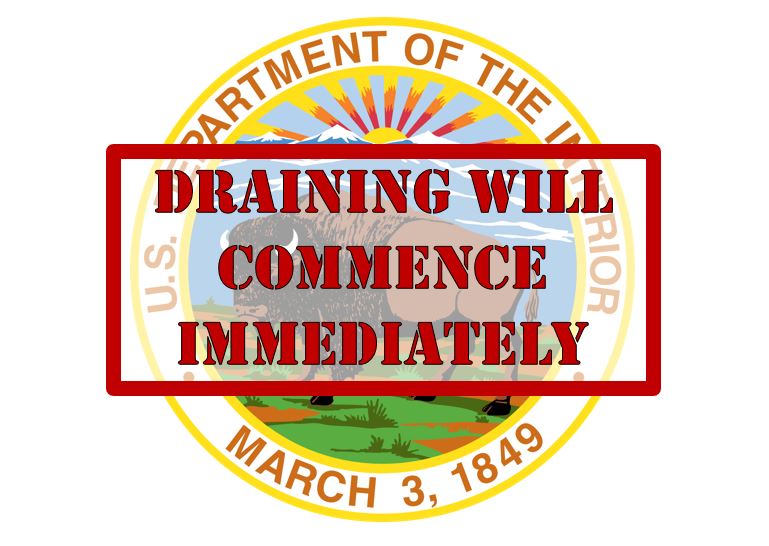The House of Representatives is now reviewing five new bills aimed at reworking unworkable and unreasonable provisions in the 1973 Endangered Species Acts, which has proven to be one of the most ineffective and economically destructive pieces of legislation ever written into law.
posted by Marjorie Haun
The House of Representatives is now reviewing five new bills aimed at reworking unworkable and unreasonable provisions in the 1973 Endangered Species Acts, which has proven to be one of the most ineffective and economically destructive pieces of legislation ever signed into law.
Issues addressed in this set of bills include the management of gray wolves, the economic impact of adding species, ensuring states and Tribal lands affected by ESA listings are included in a transparent process, easing regulations to protect and restore non-native species without having to be listed, and conforming ESA litigation (which is often brought forth by radical special interests who get big settlements) to that of other legal processes.
The House Committee on Natural Resources website details the bills, which are:
•H.R. 424 (Rep. Collin Peterson), To direct the Secretary of the Interior to reissue final rules relating to listing of the gray wolf in the Western Great Lakes and Wyoming under the Endangered Species Act of 1973, and for other purposes. “Gray Wolf State Management Act of 2017”
Numbers of gray wolves are exploding in most areas where they exist or have been introduced. This has had a severe impact on local livestock, as well as large grazing wildlife such as moose, elk, deer, etc. Ranchers and state wildlife managers have found themselves at odds with environmentalist wolf advocates who urge–and often go to court for–continued protections on what are thriving, and ecologically and economically significant predator populations. The hearing memo summarizes the issue this way:
Gray wolves were listed under the Endangered Species Act (ESA) in 1974. Existing wolves present in the Western Great Lakes Region were protected, and the federal government introduced the species canis lupus irremotus to the West by removing wolves from Canada and releasing them in central Idaho and Yellowstone National Park in 1994 and 1995. States, local citizens, livestock groups, and sportsmen opposed the reintroduction effort. The reintroduced wolf population in the West recovered and expanded more quickly than anticipated. As a result, in September 2001, the states and tribes began working with the U.S. Fish and Wildlife Service (FWS) to formulate plans that would effectively transition management responsibility to the
states upon delisting.
FWS deemed the Idaho and Montana wolf management plans adequate, but did not approve the Wyoming plan. Gray wolves were removed from the Endangered Species List on January 14, 2009. As part of their management plans, Idaho and Montana conducted tightly controlled wolf hunts beginning in the autumn of 2009. Sales of wolf hunt tags fund management activities, and hunts are conducted in a similar fashion to those of large ungulates and other wild animals under state management.
Litigious environmental groups challenged the FWS decision to delist the wolves in Idaho, Montana, and the Western Great Lakes, arguing that the rule had been politically motivated and did not comply with ESA. The U.S. District Court for the District of Montana held that the rule was a “political solution that does not comply with ESA” and that delisting of a species which was still endangered in a portion of its region (Wyoming) was not appropriate. The delisting of the wolves was halted in all states until the Wyoming plan was acceptable. See full hearing memo here.
•H.R. 717 (Rep. Pete Olson), To amend the Endangered Species Act of 1973 to require review of the economic cost of adding a species to the list of endangered species or threatened species, and for other purposes. “Listing Reform Act”
One of the starkest examples of devastating economic impact by an ESA listing is that of the spotted owl, which effectively decimated the timber industry of the American North Pacific. The Listing Reform Act is intended to prevent such sweeping economic destruction. It is summarized:
H.R. 717, the “Listing Reform Act” would authorize the Secretary of the Interior to consider economic impacts in listing decisions for threatened species, and allow preclusion of the listing if the likelihood of significant, cumulative economic effects would result from the listing, or from the resulting designation of critical habitat. See full hearing memo here.
[wp_ad_camp_1]
•H.R. 1274 (Rep. Dan Newhouse), To amend the Endangered Species Act of 1973 to require making available to States affected by determinations that species are endangered species or threatened species all data that is the basis of such determinations, and for other purposes. “State, Tribal, and Local Species Transparency and Recovery Act”
Despite the provision within the ESA requiring the federal government to cooperate with states and tribes to the greatest extent possible, history has shown that this does not always happen, and states and localities are often left out of listings and related regulatory processes. The background of this issue is summarized this way:
States have testified that the ESA as currently implemented, does not properly honor their ability to participate to the maximum extent practicable in federal ESA listing decisions. States also have stated that they are not made privy to factors utilized by the federal government in listing decisions that impact lands, communities, and species within their borders.
States are the species managers prior to a listing decision by the federal government and will become the managers of the species after a delisting decision by the federal government. States possess extensive, on-the-ground experience and expertise in science-based wildlife management principles, generation of applicable data, and the application of public policy in managing wildlife as a public asset.
In spite of the expertise and willingness of State, local, and tribal governments to participate in the ESA process, the Department of the Interior and the Department of Commerce are not required to disclose scientific information or the basis they used in making listing or critical habitat decisions to the states or to utilize scientific data generated by the states, even though states often have actual data that the federal agencies do not. See full hearing memo here.
•H.R. 2603 (Rep. Louie Gohmert), To amend the Endangered Species Act of 1973 to provide that nonnative species in the United States shall not be treated as endangered species or threatened species for purposes of that Act. “Saving America’s Endangered Species Act” or “SAVES Act”
This bill offers protections to foreign species by easing and clarifying regulatory processes for captive breeding programs. Designed to support restoration programs for international species jeopardized by poaching, or other factors outside the purview of United States law, this bill would offer protections to endangered and threatened species without necessitating an ESA listing. The hearing memo summarizes the issue this way:
The Endangered Species Act of 1973 includes protections for nonnative endangered species in an effort to encourage foreign nations to protect jeopardized species and their habitats abroad. Nonnative endangered species are regulated by the U.S. Fish and Wildlife Service (FWS) under the Endangered Species Act through the captive bred wildlife (CBW) program.
Legal captive breeding of nonnative endangered species is a conservation measure that can create healthy populations of animals to augment recovery of wild populations, decrease illegal wildlife trafficking, and increase educational opportunities relating to the species. While no federal permit is required to own listed nonnative species, those wishing to sell or buy nonnative endangered species across state lines, including zoos and private breeders, must obtain a CBW permit from FWS.
H.R. 2603 would effectively eliminate the duplicative requirement for CBW permits for nonnative endangered species in the United States and held in captivity. Ease of transfer across state lines would enhance conservation and welfare of the species by allowing owners, breeders, and conservators of the species to ensure robust, and genetically diverse populations continue to exist in the United States. See the full hearing memo here:
•H.R. 3131 (Rep. Bill Huizenga), To amend the Endangered Species Act of 1973 to conform citizen suits under that Act with other existing law, and for other purposes. “Endangered Species Litigation Reasonableness Act.”
Environmentalist groups, some with radical agendas, have taken advantage of the Equal Access to Justice Act to sue the federal government for ‘failing’ to properly protect species listed under the ESA. In so doing, the American taxpayer has paid out billions of dollars in huge settlements, which more often than not are used by such special interests to hire staff and bring on more lawyers to expand efforts to sue involved federal agencies. Known as ‘Sue & Settle,’ this long-standing practice has not just enriched radical special interests with public monies, but has given environmentalists an edge in using the ESA to halt economic activities, such as ranching, mining, logging, fishing, etc. This is made possible in large part due to the fact that there is no cap on what special interest groups which win settlements can claim for attorney’s costs. The issue is summarized this way.
Special interest attorneys representing environmental groups argue that their expertise is “specialized” to justify substantial, uncapped fees. Some special interest attorneys have collected fees as high as $750 taxpayer dollars per hour. According to records from the Department of Justice, at least two such attorneys have garnered more than $2 million in attorneys’ fees by filing ESA suits.
The taxpayer-funded Judgment Fund serves as the source for ESA-related attorneys’ fees payments. H.R. 3131 would require ESA litigants to abide by the same rules as others bringing suit against the federal government, requiring plaintiffs to prevail in order to collect attorneys’ fees, as well as impose the $125 fee cap set by EAJA. Capable environmental attorneys are no longer rare or specialized to the point where uncapped attorneys’ fees are justified. While this legislation does not restrict aggrieved parties’ ability to seek redress in court, it removes an incentive for litigious plaintiffs to request large fee awards and safeguards taxpayer dollars against abusive litigation tactics. See the full hearing memo here.
ESA revision hearing video
Free Range Report
[wp_ad_camp_3]
[wp_ad_camp_2]




I remember when assistant BLM manager Mark Chatterton was sending me & other Clark County land owners his “Notices”, that stated we may be trespassing on the desert tortoise property rights!
This is one reason I love the proposal of http://www.conservacoin.io and the work they intend to do for endangered species and communities in South Africa. A very interesting project which I really hopes gets funded for long term good, wonder if similar projects woudl work in North America